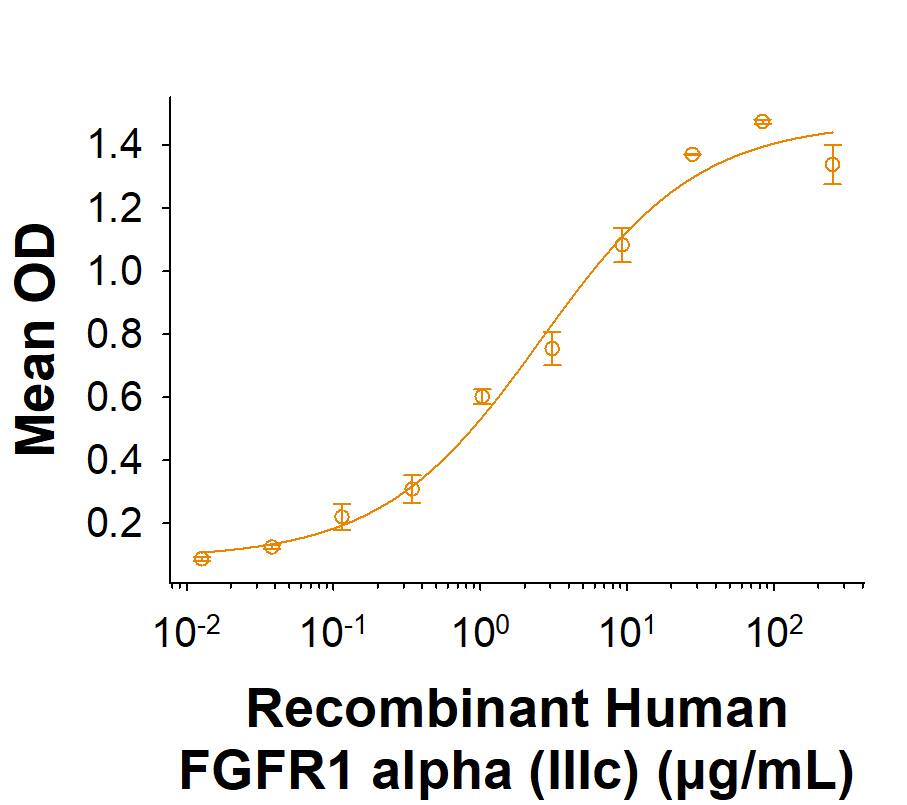Recombinant Human FGFR1 alpha (IIIc) His-tag Protein, CF
R&D Systems, part of Bio-Techne | Catalog # 11118-FR

Key Product Details
Product Specifications
Source
Human embryonic kidney cell, HEK293-derived human FGFR1 alpha protein
Arg22-Glu376, with a C-terminal 6-His tag
Arg22-Glu376, with a C-terminal 6-His tag
Purity
>95%, by SDS-PAGE visualized with Silver Staining and quantitative densitometry by Coomassie® Blue Staining.
Endotoxin Level
<0.10 EU per 1 μg of the protein by the LAL method.
N-terminal Sequence Analysis
Arg22
Predicted Molecular Mass
40 kDa
SDS-PAGE
70-85 kDa, under reducing conditions.
Scientific Data Images for Recombinant Human FGFR1 alpha (IIIc) His-tag Protein, CF
Recombinant Human FGFR1 alpha (IIIc) His-tag Protein Binding Activity.
In a Human FGF acidic/FGF1 antibody (AF232) coated plate, in the presence of 50.0 ng/mL of Recombinant Human FGF acidic/FGF1 (232-FA), Human FGFR1 alpha (IIIc) His-tag Protein (Catalog # 11118-FR) binds with an ED50 of 1.00-5.00 µg/mL.Recombinant Human FGFR1 alpha (IIIc) His-tag Protein SDS-PAGE.
2 μg/lane of Recombinant Human FGFR1 alpha (IIIc) His-tag Protein (Catalog # 11118-FR) was resolved with SDS-PAGE under reducing (R) and non-reducing (NR) conditions and visualized by Coomassie® Blue staining, showing bands at 70-85 kDa.Formulation, Preparation and Storage
11118-FR
| Formulation | Lyophilized from a 0.2 μm filtered solution in PBS with Trehalose. |
| Reconstitution | Reconstitute at 500 μg/mL in PBS. |
| Shipping | The product is shipped at ambient temperature. Upon receipt, store it immediately at the temperature recommended below. |
| Stability & Storage | Use a manual defrost freezer and avoid repeated freeze-thaw cycles.
|
Background: FGFR1 alpha
References
- Ornitz, D.M. and Itoh, N. (2015) Wiley Interdiscip. Rev. Dev. Biol. 4:215.
- Zhang, X. et al. (2006) J Biol. Chem. 281:15694.
- Ferguson, H.R. et al. (2021) Signaling Cells 10:1201.
- Holzmann, K. et al. (2012) J Nucleic. Acids 2012:950508.
- Xie, Y. et al. (2020) Sig. Transduct. Target Ther. 5:181.
- Mossahebi-Mohammadi, M. et al. (2020) Front Cell Dev. Biol. 18:79.
- Hughes, S.E. (1997) J. Histochem. Cytochem. 45:1005.
- Delezoide, A.L. et al. (1998) Mech. Dev. 77:19.
- Yamashita-Sugahara, Y. et al. (2016) Sci. Rep. 6:35908.
- Teven, C.M. et al. (2014) Genes Dis. 1:199.
- Babina, I. and Turner, N. (2017) Nat. Rev Cancer 17:318.
Long Name
Fibroblast Growth Factor Receptor 1 alpha
Alternate Names
FGF R1a
UniProt
Additional FGFR1 alpha Products
Product Documents for Recombinant Human FGFR1 alpha (IIIc) His-tag Protein, CF
Product Specific Notices for Recombinant Human FGFR1 alpha (IIIc) His-tag Protein, CF
For research use only
